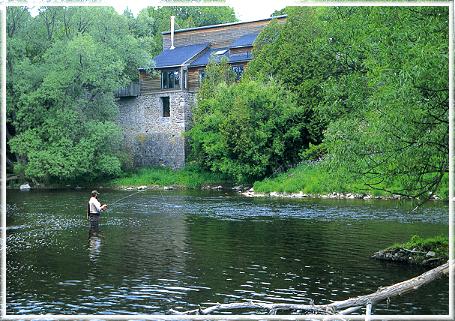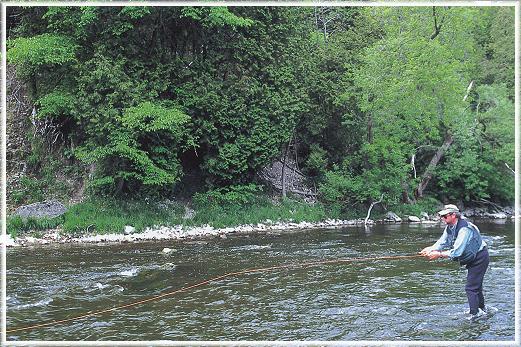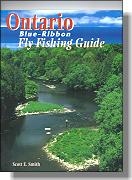The Blue-Ribbon Grand
By Scott E. Smith
There are numerous examples around North America on how conservations
can convert a relatively insignificant watershed into a blue-ribbon trout stream,
the Grand River is Ontario's shining example of just that.

Several years ago the transformation began; thanks to the insight of a group of
Southern Ontario biologists and fly anglers. Due in part to the growing angling
pressures on other streams, and the desire to diversify area fishing opportunities,
this group - comprised of Ministry of Natural Resources biologists Larry Halyk
and Jack Imhof, Warren Yerex of Grand River Conservation Authority, and
Trout Unlimited representative Walt Crawford - began to look at the productive
Grand for a solution. Some experimentation with rainbow trout had occured on the
Grand with marginal success; the fishery was not self-sustaining, rather it was
strictly a put-and-take project, and a poor one at that. Many of the rainbow
trout stock migrated downstream and probably became a part of the steelhead
fishery in the lower river. The desire was for a reverine strain of fish that would
provide sport in the upper river throughout the trout season from late April to the
end of September. A biological survey done on the stream showed the river was
much better suited for a brown trout population; subsequently a fisheries plan
was formulated and submitted by Larry Halyk in 1988. This resulted in an
extensive stocking initiative, beginning in 1989, from a variety of hatchery sources.
In 1993, special regulations were placed on a 13-kilometer stretch of the Grand
making it catch-and-release (single-hook-barbless, artificials only). Today this
stretch of easily waded and accessed stream rivals the best tailwater fisheries
anywhere, and if affectionately referred to as the "Blue-Ribbon Grand." Presently
strains from other rivers in Southern Ontario are being introduced into the system
to further broaden the genetic base for the Grand River population. Some
successful spawning does occur, but at this time, the majority of the brown trout
caught are stocked fish. This trend will hopefully change as concerned parties,
such as the Friends of the Grand River and several fly-angling groups, along with
the Grand River Conservation Authority and the M.N.R., are presently developing
water quality and spawning area enhancement plans.
This blue-ribbon section I speak of is just north of the city of Guelph. Shand Dam
on Belwood Lake, just 5 kilometers north of the town of Fergus, is the source of
the tailwater fishery. The dam was modified for hydoelectric purposes in 1998
resulting in a cold-water discharge. This factor, combined with the natural
occurrence of cold-water upwelling and the high-nutrient qualities of the river,
makes the Grand a prolific trout stream. Abundant hatches of virtually every
important insect to the sport of fly fishing are well represented in this upper section
of river. Further, the nutrient values of this stream have been augmented by the upgrading
of sewage-treatment practices within the catchment area of this system over the last
ten years, an area populated by an astounding 730,000 people. This high-population
living within the drainage is really a good thing. As explained by G.R.C.A. representative
Warren Yerex, the Grand River drainage is the largest populated area in Canada that is
dependent on a singular source of ground-water from a river for its water consumption
needs. Most urban areas draw from large bodies - such as the Great Lakes - for their
water source. Given that the Grand is also used for the treatment of sewage for the
majority of the inhabitants in the drainage, water quality becomes a very important
issue of everyone - anglers and consumers alike. This results in a plus-plus situation.
Consumers demand high water quality, hence sewage treatment systems are
continually being upgraded, resulting in increasing better water quality in the river.
This is good for the brown trout, and fly anglers as well. The whole circle sounds
distasteful, but it is a fact of life in populated areas. The issue of human effluent
being a boon to a trout population is one of the 'R-rated' factors behind the scenes
on many a blue-ribbon trout stream.
All told, there are three sections of catch-and-release brown-trout water on the
Grand. Section 1: approximately 2.5 kilometers from the West Garafraxa 2nd
line to Scotland Street in the town of Fergus; Section 2: approximately 5.5
kilometers, between Tower Street in Fergus to Bissel Dam in the town of Elora;
and Section 3: approximately 5 kilometers, fromm 100 meters downstream of
the "low level" bridge in the Elora Gorge Conservation Area to 100 meters upstream
of the Pilkington 2nd line.
Although these areas are marked with signs, the parameters of these borders likely
mean beans to you at this point, unless you're sitting with a detailed map on your
lap. Notwithstanding, if you're like me and need one of those "You are Here"
shopping-mall signs when you're standing on the banks of a strange river, you
are best advised to employ a guide, at least for your first few trips. Indeed
the benefits of hiring a guide on any renowned trout stream are numerous: you
want to be sure to spend your time fishing the best water; to make sure you are
legally fishing, and not on private property or sanctuary water; and to ensure that
you are fishing the right flies, in the right manner, at the right time of day. These
reasons are so true for the Grand. Knowledgable guides - such as John Valk and
Barney Jones of Grindstone Angling Specialties in Waterdown, Ontario - know
the river intimately. They not only know which stretches hold the biggest fish,
the most fish, and the toughest-to-hook fish, they even know their names! Like
many brown-trout rivers, the Grand has those ageless denizens of certain pools
that inspire that reverie and gossip that is familiar to any fly shop. A good guide
has the goods on when the big seven-pounder was last hooked at Blondies
(in Section 3) and what it was hooked on. This likely means that this big fish
won't that the same pattern again, at least for a while. Good guides are priceless
on the Grand for all of these reasons.
I've mentioned the 13 kilometers of special regulation water, but in 1999
the Ontario government introduced legislation to double the amount of
special regulation water on the Grand River. This additional water is
broken in two sections, which begin downstream of section 3. Section
4, approximately 5 km of river, begins 100m downstream of Pilkington
2nd Line and continues to 100m upstream of the Pilkington Township and
Woolwich Township boundary line. Section 5, the longest section of
the special regulation's water (8 kilometers), starts 100m downstream of the
Pilkington Township and Woolwich Township boundary line and continues
downstream to a point 100m upstream of Highway 86 (about 2 kilometers
upstream of the town of West Montrose). Naturally, anglers that are
unfamiliar with these boundaries would we wise to employ a guide, or
at the very least refer to a current copy of the Ontario fishing regulations and
a good regional road map.
Special regulations now apply to almost all of the 28 kilometers of tailwater/brown
trout water on the Grand river from Shand Dam downstream to the picturesque
town of West Montrose where the last covered bridge in Southern Ontario
crosses the Grand. This 28-kilometer tailwater section is divided, in geographical
terms, into two sections of river: The upper river flows over a bedrock base
and through a limestone canyon, known as Elora Gorge, with sheer cliffs up to
100 feet high; and the lower river from the downstream end of the gorge (designated
by the bridge that crosses the river there known as the "low-level bridge") to
West Montrose. This latter portion of the river has a slower gradient, more
occurrences of sand, gravel and upwellings, and a good riffle-run-pool ratio;
making this stretch a more classic piece of fly-fishing water as compared to
the faster, bed-rock-channeled, upper portion of the stream. These two
stretches of river both fish well, but have their own intrinsic differences in
hatches and character. The lower stretch is also the area of the river that is
best suited for spawning, and may later become a more self-sustaining
piece of water. Plans for extending special regulations to include the entire
tailwater sections of the Grand are in the works, as are plans to augment
spawning habitats in the upper, gorge area of the river.

Fly fishing the Grand is a pleasure. The river averages about 50 feet in width
throughout the special regulations area and its flows vary from 140 to 350 cfs.
It is pleasantly wadable, and crossed fairly easily in many places. The inherent
productivity of the river means there are lots of algae-covered rocks to slip on,
so bring your felt soles at the least. I prefer studded-felts for this type of river,
 as felt alone doesn't always do the trick on snotty rock. A wading staff is another
good measure of prevention.
~ Scott E. Smith
as felt alone doesn't always do the trick on snotty rock. A wading staff is another
good measure of prevention.
~ Scott E. Smith
Next time fishing the Grand!
From: Ontario Blue-Ribbon Fly Fishing Guide.We thank
Frank Amato Publications, Inc. for re-print permission!
|




 as felt alone doesn't always do the trick on snotty rock. A wading staff is another
good measure of prevention.
~ Scott E. Smith
as felt alone doesn't always do the trick on snotty rock. A wading staff is another
good measure of prevention.
~ Scott E. Smith



 as felt alone doesn't always do the trick on snotty rock. A wading staff is another
good measure of prevention.
~ Scott E. Smith
as felt alone doesn't always do the trick on snotty rock. A wading staff is another
good measure of prevention.
~ Scott E. Smith